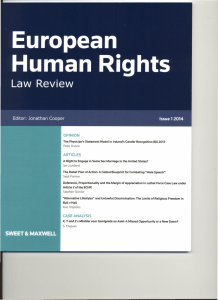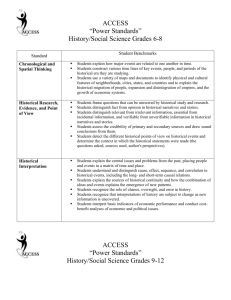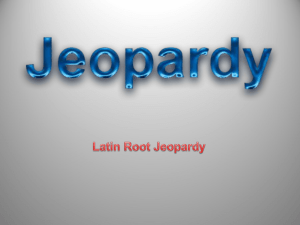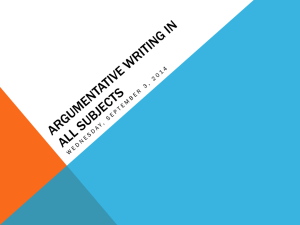III. STANDARDS OF REVIEW: NONSTATUTORY LEGAL ISSUES
advertisement
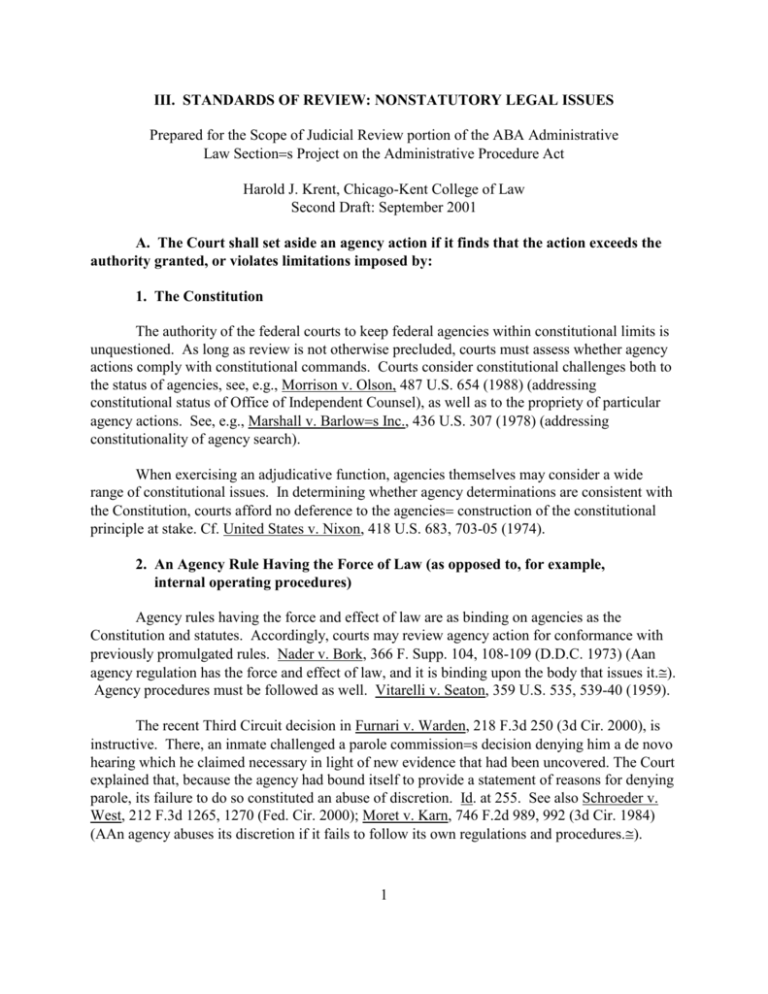
III. STANDARDS OF REVIEW: NONSTATUTORY LEGAL ISSUES Prepared for the Scope of Judicial Review portion of the ABA Administrative Law Sections Project on the Administrative Procedure Act Harold J. Krent, Chicago-Kent College of Law Second Draft: September 2001 A. The Court shall set aside an agency action if it finds that the action exceeds the authority granted, or violates limitations imposed by: 1. The Constitution The authority of the federal courts to keep federal agencies within constitutional limits is unquestioned. As long as review is not otherwise precluded, courts must assess whether agency actions comply with constitutional commands. Courts consider constitutional challenges both to the status of agencies, see, e.g., Morrison v. Olson, 487 U.S. 654 (1988) (addressing constitutional status of Office of Independent Counsel), as well as to the propriety of particular agency actions. See, e.g., Marshall v. Barlows Inc., 436 U.S. 307 (1978) (addressing constitutionality of agency search). When exercising an adjudicative function, agencies themselves may consider a wide range of constitutional issues. In determining whether agency determinations are consistent with the Constitution, courts afford no deference to the agencies construction of the constitutional principle at stake. Cf. United States v. Nixon, 418 U.S. 683, 703-05 (1974). 2. An Agency Rule Having the Force of Law (as opposed to, for example, internal operating procedures) Agency rules having the force and effect of law are as binding on agencies as the Constitution and statutes. Accordingly, courts may review agency action for conformance with previously promulgated rules. Nader v. Bork, 366 F. Supp. 104, 108-109 (D.D.C. 1973) (an agency regulation has the force and effect of law, and it is binding upon the body that issues it.). Agency procedures must be followed as well. Vitarelli v. Seaton, 359 U.S. 535, 539-40 (1959). The recent Third Circuit decision in Furnari v. Warden, 218 F.3d 250 (3d Cir. 2000), is instructive. There, an inmate challenged a parole commissions decision denying him a de novo hearing which he claimed necessary in light of new evidence that had been uncovered. The Court explained that, because the agency had bound itself to provide a statement of reasons for denying parole, its failure to do so constituted an abuse of discretion. Id. at 255. See also Schroeder v. West, 212 F.3d 1265, 1270 (Fed. Cir. 2000); Moret v. Karn, 746 F.2d 989, 992 (3d Cir. 1984) (An agency abuses its discretion if it fails to follow its own regulations and procedures.). 1 The question of agencies compliance with their own regulations turns on two factors. First, the regulation must have the force of law. Agency regulations more akin to internal operating procedures bind the agency as a matter of politics but not law. Private parties cannot sue the agency directly for failure to comply with rules or policy statements lacking the force of law. See, e.g., Haitian Refugee Center v. Baker, 953 F.2d 1498, 1508 (11th Cir. 1992); De Silva v. Smith, 773 F.2d 1021 (9th Cir. 1985); Pasquini v. Morris, 700 F.2d 658, 662-62 (11th Cir. 1983); cf. In re Surface Mining Regulation Litigation, 627 F.2d 1346, 1357 (D.C. Cir. 1980) (stating that agency directive implementing Presidents Executive Order to be treated as discretionary rule). Unlike the situation in Furnari, such rules will be enforced at the discretion of the agency. This is not to suggest that agency internal operating procedures, general statements of agency policy, or rules in staff manuals have no impact. When published, agencies can rely on such rules, 5 U.S.C. 552a, and if agencies depart from their terms, they must explain why they are changing the rules of the game midstream. Thus, even though internal operating procedures and staff manuals may not be directly enforceable, aggrieved litigants may argue successfully that the agency acted arbitrarily by failing to comply with previously articulated rules. The theory of such relief would not be reversal as a matter of law, but reversal because of an abuse of discretion the action is without legitimate reason and adequate explanation, inconsistent with prior agency policies or procedures. (Scope of Review Statement, V.F.).1 Second, disputes often arise over the meaning of the regulations that agencies must follow. As with statutes, regulations can be, and often are, ambiguous. Courts must then decide how much weight to afford the agencys interpretation of the regulation. Although courts would have no reason to defer to an agencys construction of another agencys regulation, see Martin v. OSHRC, 499 U.S. 144 (1991); Director, OWCP v. General Dynamics Corp., 982 F.2d 790, 795 (2d Cir. 1992), for reasons analogous to Chevron courts might uphold an agencys construction of its own regulation as long as it is reasonable. Indeed, courts may have more reason to permit agencies to flesh out their own regulations than to interpret the statutory terms set by Congress. The process by which the agency formulates its rules, however, ultimately may dictate whether stronger or weaker deference is afforded. In Bowles v. Seminole Rock & Sand Co., 325 U.S. 410 (1945), the Supreme Court held that deference was due an agencys interpretation of its own regulation. In considering a dispute over a regulation issued by the Office of Price Administration, the Court concluded that the Secretarys own interpretation of the contested words highest price should control: Since this [case] involves an interpretation of an administrative regulation a court must necessarily look to the administrative construction of the regulation if the meaning of the words used is in doubt. . . [T]he ultimate criterion is the administrative interpretation, which becomes of controlling 1 Some internal rules are merely precatory, and courts rarely will find that agencies acted arbitrarily merely by failing to follow such rules. 2 weight unless it is plainly erroneous or inconsistent with the regulation. Id. at 413-14. The Court has often invoked Seminole Rock and reiterated its plainly erroneous or inconsistent standard. See, e.g., Thomas Jefferson University v. Shalala, 512 U.S. 504, 512 (1994) (collecting examples). The rationale for deferring to an agencys interpretation of its own regulations is analogous to Chevron. If Congress has delegated power to the agency to fill in legislative gaps, then courts should defer to any reasonable interpretations that the agency forwards of its own gap-filling regulations. It is more legitimate for an agency than a court to undertake that function: the power authoritatively to interpret its own regulations is a component of the agencys delegated lawmaking powers.2 The agency has more expertise, and is more politically accountable than courts. Congress, in other words, has entrusted agencies with the power to make law through regulations and to define what those regulations mean. Consider the Supreme Courts decision in Auer v. Robbins, 519 U.S. 452 (1997). The dispute focused on the Department of Labors regulation fleshing out the meaning of the Federal Labor Standards Acts exemption for employees acting in executive, administrative, or professional capacity. 29 U.S.C. 213(a)(1). The agencys regulation determined that an employee paid on a salary basis was exempted from the Acts protections. 29 C.F.R. 541.1(f). That exception included employees whose salary was not subject to reduction because of variations in the quality or quantity of the work performed. 29 C.F.R. 54.118(a). In litigation, the agency clarified that, to qualify as a salaried employee, no deduction for shoddy work could be made in practice, or there must be a significant likelihood that, if an employee violates the pertinent work rules, the employee will be disciplined in a manner inconsistent with the salary basis rule. Writing for the unanimous Court, Justice Scalia held that the agencys interpretation of the regulation, even though forwarded for the first time in a brief, should be entitled to Seminole Rock deference. According to the Court, the Secretarys interpretation of the regulation is controlling unless plainly erroneous or inconsistent with the regulation. Id. at 911 (quoting Seminole Rock). The Court explained that there is simply no reason to suspect that the interpretation does not reflect the agencys fair and considered judgment on the matter in question. 519 U.S. at 462. Auer suggests, therefore, that strong deference always should be afforded agency interpretation of the regulations the agency has issued. Many lower court decisions have followed Auers lead. See, e.g., National Wildlife Fedn v. Browner, 127 F.3d 1126, 1130 (D.C. Cir. 1997); Public Citizen v. Carlin, 184 F.3d 900, 911 (D.C. Cir. 1999); Akzo Nobel Salt, Inc. v. Federal Mine Safety and Health Review Commn, 212 F.2d 1301 (D.C. Cir. 2000). 2 Martin v. Occupational Safety & Health Review Commn, 499 U.S. 144, 151 (1991). 3 Exactly how Seminole Rock deference compares to Chevron deference is difficult to say with great confidence. The usual judicial formulations of Seminole Rock deference certainly sound (even) more deferential than Chevron. For example, in Thomas Jefferson University v. Shalala, the Supreme Court stated that it must give substantial deference to an agencys interpretation of its own regulations. 512 U.S. at 512 (citations omitted). Explaining further, the Court wrote: Our task is not to decide which among several competing interpretations best serves the regulatory purpose. . . . In other words, we must defer to the Secretarys interpretation unless an alternative reading is compelled by the regulations plain language or by other indications of the Secretarys intent at the time of the regulations promulgation. Id. (quoting Gardebring v. Jenkins, 485 U.S. 415, 430 (1988)). The Court added that this broad deference is warranted especially where the regulation concerns a complex, technical regulatory program. Id. Perhaps the Court was convinced that agencies are better situated to understand their own ambiguous regulations as opposed to open-ended terms passed by Congress. Thus, Seminole Rock might be understood as Chevron plus deference, whereas Skidmore can be understood as Chevron minus deference. Nonetheless, despite the theoretical difference in strength of deference, the Seminole Rock and Chevron formulations likely converge in practice. As the D.C. Circuit noted in Paralyzed Veterans of America v. D.C. Arena L.P., 117 F.3d 579, 584-85 (D.C. Cir. 1997), [i]n the aftermath of Chevron, it may be that our deference to agency interpretations of ambiguous regulations is not different than that which we afford to interpretations of ambiguous statutes. It would seem that there are few, if any, cases in which the standard applicable under Chevron would yield a different result than the plainly erroneous or inconsistent standard set forth in Bowles. Similarly, the Supreme Court in Martin v. OHSRC, 499 U.S. 144, 180 (1991), directed courts to defer to agency interpretations of regulations if the Secretarys interpretation is reasonable. The Secretarys interpretation of an ambiguous regulation is subject to the same standard of substantive review as any other exercise of delegated lawmaking power. Some have criticized Seminole Rock deference, however, on the ground that agencies should not have the power to both make and interpret the law.3 Fusing the power to fashion rules and then interpret them might endanger civil liberties. Moreover, if agencies can both promulgate regulations and then interpret them, they might have the incentive to issue overly vague rules, knowing that they could then flesh out the rules through interpretations that would avoid stringent review.4 Agencies can avoid procedures such as notice-and-comment rulemaking merely by reinterpreting their own regulations in an enforcement action. 3 See generally John F. Manning, Constitutional Structure and Judicial Deference to Agency Interpretations of Agency Rules, 96 Colum. L. Rev. 612 (1996); Robert A. Anthony, The Supreme Court and the APA: Sometimes They Just Dont Get It, 10 Admin. L. J. Am. U. 1 (1996). 4 See, e.g., Jonathan T. Molot, Judicial Perspective in the Administrative State: Reconciling Modern Doctrines of Deference with the Judiciarys Structural Role, 53 Stan. L. 4 Commentators criticizing Seminole Rock argue instead that less generous deference should be afforded such agency interpretations under the doctrine articulated in Skidmore v. Swift & Co. , 323 U.S. 134 (1944). The Skidmore standard provides that an agencys interpretive position is entitled to respect and that the weight of such a judgment in a particular case will depend upon the thoroughness evident in its consideration, the validity of its reasoning, its consistency with earlier and later pronouncements, and all those factors which give it power to persuade, if lacking power to control. Id. at 140. The more stringent review ex post would in turn sharpen the ex ante incentives for clearer rules. Rev. 1, 105-07 (2000); Manning, supra, at 655. 5 Such arguments, however, are not fully persuasive. First, Congress possesses the same check of revising the delegation irrespective of whether the agency is interpreting a statute or a regulation. Congress can overrule or modify the one just as easily as the other. Second, if a court overturns an agencys interpretation, the agency can reissue a clarified regulation that reflects its current interpretation. Third, the separation of powers argument is not dispositive given that agencies widely interpret both statutes and regulations in enforcing their legislatively delegated tasks. Indeed, agencies exercise a mixture of functions in many contexts. Cf. Withrow v. Larkin, 421 U.S. 35 (1975). Fourth, one would think that agencies have greater expertise in divining the meaning of agency regulation than courts. Courts construing regulations might supplant agencies as subsidiary policymakers under delegated grants of authority from Congress. Although agencies can always issue a revised regulation, a judicial gloss raises the costs of maintaining the agencys preferred regulatory interpretation. Fifth, agency interpretations of regulations must of necessity include interpretations of the statutory language the regulations were designed to implement. Chevron deference to interpretations of statutes in regulations, therefore, logically should extend to deference of interpretations of those regulations themselves. Finally, at times clearer rules do not serve the public interest. A standard-like rule may better protect the public than if the agency were compelled to issue bright-line rules.5 Yet, a different argument against strong deference to agency interpretations of regulations may be more convincing. In most contexts, the agencys interpretation is not preceded by notice and comment; nor has it emerged from the agencys adjudicative role. Rather, the interpretation often arises in the midst of enforcing the law, hardly a circumstance that gives one confidence that the resulting interpretation has been well considered. From a political process perspective, strong deference seems unwarranted if the agency interpretation has been hastily reached and little discussed. Indeed, the Supreme Courts recent decision in Christensen v. Harris County, 120 S. Ct. 1655 (2000), by curtailing Chevron deference for an opinion letter, might by analogy caution against strong deference to agency interpretations of their own regulations. The Court in Christensen concluded that interpretations contained in policy statements, agency manuals, and enforcement guidelines, all of which lack the force of law[,] do not warrant Chevron-style deference. 120 S. Ct. at 1663. Christensen suggests that Chevron deference principally should be reserved for agency interpretations issued as part of the rulemaking or adjudication process. 5 For a defense of Seminole Rock, see generally Scott H. Angstreich, Shoring Up Chevron: A Defense of Seminole Rock Deference to Agency Regulatory Interpretations, 34 U. C. Davis L. Rev. 49 (2000). 6 Viewed another way, a court should only accord an agency interpretation strong deference when the agency is interpreting a regulation in a context in which Congress intended the agency act to have the force of law.6 Agencies interpret regulations most often in contexts in which one cannot easily infer a congressional delegation of the power to make law, whether in litigation or opinion letters. Indeed, most agency interpretations of regulations are not the outgrowth of any defined process, have not been tested by the crucible of public participation (through rulemaking or adjudication before the agency), and may reflect nothing more than the result of litigation pressures. Congress would not lightly imbue such interpretations with the presumption of correctness. Ultimately, the question of the degree of deference to afford agency interpretations of their own regulations presents a close question that eventually will be resolved by the Supreme Court. The Christensen process perspective suggests, however, that only Skidmore deference should be afforded to agency interpretations of regulations that are forwarded outside of either a rulemaking or adjudication. Cf. Mission Group Kansas, Inc. v. Riley, 146 F.3d 775 (10th Cir. 1998) (refusing to accord strong deference to agency interpretation of regulation because interpretation not subject to notice and comment rulemaking); IAL Aircraft Holding, Inc. v. FAA, 206 F.3d 1042, 1045-46 (9th Cir. 2000) (refusing to extend deference to agency interpretation of its regulation on grounds that interpretation was litigating position that agency had not expressed elsewhere before).7 Note that the question of whether to defer to agency interpretations of their own interpretive rules or policy statements will seldom arise given that so little turns on whether the agency interpretation is correct -- the interpretive rules and policy statements themselves only warrant Skidmore deference. See, e.g., Shalala v. Guernsey Memorial Hospital, 514 U.S. 87, 99 (1995) (relating that interpretive rules do not have the force and effect of law and are not accorded that weight in the adjudicatory process.); Hoctor v. United States Dept of Agriculture, 82 F.3d 165 (7th Cir. 1996). On the other hand, some interpretations of substantive or legislative regulations will be articulated in an agency adjudication or in a rulemaking. In those settings, the agencys interpretation is reached only after consideration is given to future applications. Such interpretations merit the full Seminole Rock deference. Thus, Christensen arguably augurs a significant limitation of Auer, and the deference accorded agency interpretation of regulations should hinge on the context in which the interpretation is forwarded. 3. Federal Common Law (in the rare cases in which it applies) 6 See Robert A. Anthony, Which Agency Interpretations Should Bind Citizens and the Courts?, 7 Yale J. on Reg. 1, 39-40 (1990). 7 Cf. Donna Nagy, Judicial Reliance on Regulatory Interpretations in SEC No-Action Letters: Current Problems and a Proposed Network, 83 Corn. L. Rev. 921, 992-993 (1998) (addressing question of judicial deference to SEC interpretation of its rules in SEC No-Action letters). 7 Federal courts rarely assert federal common law as a basis for constraining agencies. On occasion, however, courts have relied squarely on their own lawmaking authority to invalidate administrative decisions on such grounds as res judicata and collateral estoppel. Tait v. Western Md. Ry., 289 U.S. 620 (1933); Clark-Cowlitz Joint Operating Agency v. FERC, 775 F.2d 366, 373-76 (D.C. Cir. 1985). For instance, consider the First Circuits decision in Bath Iron Works Corp. v. Director, OWCP, 125 F.3d 18 (1st Cir. 1997). There, an employee injured on the job obtained benefits pursuant to state workers compensation proceedings. He received an award of 25% disability due to a serious knee injury and when the disability deepened over time successfully applied for an increase to a 50% award. Thereafter, the employee sought a further award from the employer under the Longshore Act, 33 U.S.C. 901, et seq. The Department of Labor Benefits Review Board granted him full disability, rejecting the employers collateral estoppel argument. The First Circuit, however, reversed the agencys determination, holding that the agency should have given collateral estoppel effect to the state agencys prior determination: the tendency is plainly in favor of applying collateral estoppel in administrative contexts. Id. at 21. The court imposed federal common law requirements on the agency. 4. Any Other Source of Law That is Binding on the Agency, Including a Consent Decree or Other Judicial Order, International Law, and (to the extent applicable and enforceable by their terms) Executive Orders Subsection 4 is a catchall section that covers sources of law other than those mentioned above. Courts may independently construe and redress violations of, all sources of law. For instance, in United States v. Armour & Co., 402 U.S. 673, 681-83 (1971), the Court considered applicability of a consent decree, and of growing importance, agencies must follow the law of nations as well as domestic law. Cf. Weinberger v. Rossi, 456 U.S. 25 (1982) (construing regulation narrowly to avoid conflict with the law of nations). At times agencies must abide by executive orders. See, e.g. CIA v. Sims, 471 U.S. 159 (1985); Weinberger v. Romero-Barcelo, 456 U.S. 305 (1982). However, most executive orders stem from the Presidents inherent authority to manage the executive branch and therefore do not provide an enforceable limit on the agencys powers. The agency head may face political repercussions for not following such orders, but no secondguessing in court. See Xin-Chang Zhang v. Slattery, 55 F.3d 732 (2d Cir. 1995) (For whatever reasons, the Attorney General did not adhere to this order and the Bush Administration did not follow up on it. However, it is not the role of the federal courts to administer the executive branch.); Chen Zhou Chai v. Carroll, 48 F.3d 1331 (4th Cir. 1995); In re Surface Mining Regulation Litigation, 627 F.2d 1346, 1357 (D.C. Cir. 1980); Independent Meat Packers Assn v. Butz, 526 F2d 228, 234 (8th Cir. 1975). 8
